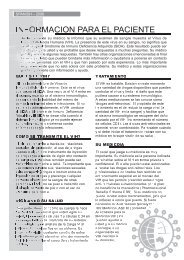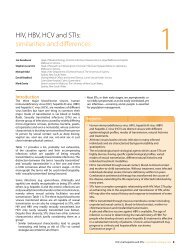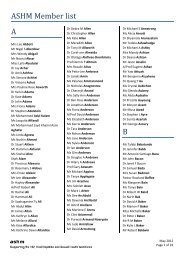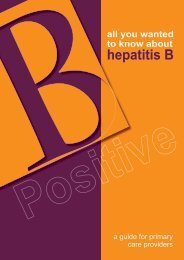Chapter 13 - Standard precautions and infection control - ASHM
Chapter 13 - Standard precautions and infection control - ASHM
Chapter 13 - Standard precautions and infection control - ASHM
Create successful ePaper yourself
Turn your PDF publications into a flip-book with our unique Google optimized e-Paper software.
• <strong>St<strong>and</strong>ard</strong> <strong>precautions</strong> including use of personal<br />
protective equipment apply where there is a risk<br />
of contact with blood or body substances<br />
• Spills should be cleaned up before the area is<br />
disinfected<br />
• Generation of aerosols from spilled material should<br />
be avoided<br />
All spills must be dealt with as soon as possible. In<br />
general cleaning blood <strong>and</strong> body substance spills<br />
should take into account the following factors:<br />
• The nature of the spill (e.g. sputum, vomit, faeces,<br />
urine, blood or laboratory culture)<br />
• The pathogens most likely to be involved in the<br />
spill<br />
• The size of the spill (spot, small or large spill)<br />
• The type of surface (e.g. carpet or impervious<br />
flooring)<br />
• The area involved (i.e. whether the spill occurs in a<br />
contained area such as a microbiology laboratory<br />
or in a public area such as a hospital ward or<br />
outpatient area)<br />
• The likelihood of bare skin contact with the soiled<br />
surface.<br />
In the case of a small spill, wipe the area clean using<br />
a paper towel <strong>and</strong> then clean with detergent <strong>and</strong><br />
warm water. A disposable alcohol wipe also may be<br />
used. Quarantine areas where soft furnishings are<br />
involved (carpet, curtains or seating) until dry. In the<br />
case of larger spills mop up with paper towel or use<br />
'kitty litter' or granular chlorine, picking up the larger<br />
amount with cardboard.<br />
In general, it is unnecessary to use sodium<br />
hypochlorite for managing spills because there is<br />
no evidence of any benefit from an <strong>infection</strong> <strong>control</strong><br />
perspective. However, it is recognised that some<br />
health care workers may feel more reassured that<br />
the risk of <strong>infection</strong> is reduced through the use of<br />
sodium hypochlorite.<br />
Legal <strong>and</strong> ethical issues<br />
Legal liability may occur if inadequate care<br />
has been taken to prevent the transmission of<br />
<strong>infection</strong> in the health care setting. Regulatory<br />
authorities, including environmental protection<br />
services <strong>and</strong> Commonwealth, State/Territory <strong>and</strong><br />
local governments, enforce laws <strong>and</strong> regulations<br />
relating to <strong>infection</strong> <strong>control</strong> <strong>and</strong> waste disposal.<br />
These regulations can vary considerably throughout<br />
Australia <strong>and</strong> such regulations should take<br />
precedence over the general information presented<br />
in this chapter. For further information contact State<br />
<strong>and</strong> Territory health departments <strong>and</strong> medical <strong>and</strong><br />
other professional boards (refer to <strong>ASHM</strong> Directory<br />
available at www.ashm.org.au/ashm-directory). Legal<br />
issues are considered in greater detail in <strong>Chapter</strong> 14.<br />
Summary<br />
<strong>St<strong>and</strong>ard</strong> <strong>precautions</strong> <strong>and</strong> <strong>infection</strong> <strong>control</strong><br />
procedures protect against transmission of bloodborne<br />
viruses including HIV, HBV <strong>and</strong> HCV in the<br />
health care setting. Regardless of the perceived risk<br />
or assumptions about a patient's <strong>infection</strong> status,<br />
<strong>infection</strong> <strong>control</strong> procedures must be followed in all<br />
clinical settings to minimise the risk of transmission<br />
of blood-borne viruses.<br />
References<br />
1 Communicable Diseases Network of Australia<br />
(CDNA), National Public Health Partnership (NPHP),<br />
<strong>and</strong> Australian Health Ministers’ Advisory Council<br />
(AHMAC). Infection <strong>control</strong> guidelines for the<br />
prevention of transmission of infectious diseases in<br />
the health care setting. Canberra: Commonwealth<br />
Department of Health <strong>and</strong> Ageing; 2004. Available<br />
from http://www.health.gov.au/internet/wcms/<br />
Publishing.nsf/Content/icg-guidelines-index.htm<br />
2 Australian Government Department of Health <strong>and</strong><br />
Ageing. Australian Immunisation H<strong>and</strong>book, 9th Ed.<br />
Canberra; Commonwealth Department of Health<br />
<strong>and</strong> Ageing; 2008.<br />
Further reading<br />
The Royal Australian College of General Practice,<br />
Infection Control <strong>St<strong>and</strong>ard</strong>s for Office-based Practices<br />
(4th Edition) can be obtained from the RACGP<br />
Publications Department on (03) 8699 0495, or by<br />
downloading the order form at www.racgp.org.au/<br />
publications/orders <strong>and</strong> faxing back to (03) 8699<br />
0400. The cost is $88 for RACGP members <strong>and</strong> $<strong>13</strong>2<br />
for non-members. For further information contact<br />
RACGP Publications on publications@racgp.org.au or<br />
st<strong>and</strong>ards@racgp.org.au<br />
HIV, viral hepatitis <strong>and</strong> STIs: a guide for primary care 151






